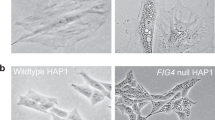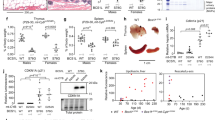Abstract
The peroxisome biogenesis disorders (PBDs) are a group of lethal autosomal-recessive diseases caused by defects in peroxisomal matrix protein import, with the concomitant loss of multiple peroxisomal enzyme activities. Ten complementation groups (CGs) have been identified for the PBDs, with CG1 accounting for 51% of all PBD patients. We identified the human orthologue of yeast PEX1, a gene required for peroxisomal matrix protein import. Expression of human PEX1 restored peroxisomal protein import in fibroblasts from 30 CG1 patients, and PEX1 mutations were detected in multiple CG1 probands. A common PEX1 allele, G843D, is present in approximately half of CG1 patients and has a deleterious effect on PEX1 activity. Phenotypic analysis of PEX1deficient cells revealed severe defects in peroxisomal matrix protein import and destabilization of PEX5, the receptor for the type1 peroxisomal targeting signal, even though peroxisomes were present in these cells and capable of importing peroxisomal membrane proteins. These data demonstrate an important role for PEX1 in peroxisome biogenesis and suggest that mutations in this gene are the most common cause of the PBDs
This is a preview of subscription content, access via your institution
Access options
Subscribe to this journal
Receive 12 print issues and online access
$209.00 per year
only $17.42 per issue
Buy this article
- Purchase on Springer Link
- Instant access to full article PDF
Prices may be subject to local taxes which are calculated during checkout
Similar content being viewed by others
References
van den Bosch, H., Schutgens, R.B.H., Wanders, R.J.A. & Tager, J.M. Biochemistry of peroxisomes. Annu. Rev. Biochem. 61, 157–197 (1992).
Gould, S.J., Keller, G.A., Hosken, N., Wilkinson, J. & Subramani, S. A conserved tripeptide sorts proteins to peroxisomes. J. Cell Biol. 108, 1657–166 (1989).
Swinkels, B.W., Gould, S.J., Bodnar, A.G., Rachubinski, R.A. & Subramani, S. A novel, cleavable peroxisomal targeting signal at the ammo-terminus of the rat 3-ketoacyl-CoAthiolase. EMBO J. 10, 3255–3262 (1991).
Dyer, J.M., McNew, J.A. & Goodman, J.M. The sorting sequence of the peroxisomal integral membrane protein PMP47 is contained within a short hydrophilic loop. J. Cell Biol. 133, 269–280 (1996).
Lazarow, P.B. & Fujiki, Y. Biogenesis of peroxisomes. Annu. Rev. Cell. Biol. 1, 489–530 (1985).
Lazarow, P.B., Moser, H.W. Disorders of peroxisome biogenesis . in The Metabolic and Molecular Bases of Inherited Disease (eds Scriver, C. R. et al.) 2287–2324 (McGraw-Hill, New York, 1995).
Braverman, N. et al. Human PEX7 encodes the peroxisomal PTS2 receptor and is responsible for rhizomelic chondrodysplasia punctata. Nature Genet. 15, 369–376 (1997).
Motley, A.M. et al. Rhizomelic chondrodysplasia punctata is a peroxisomal protein targeting disease caused by a non-functional PTS2 receptor. Nature Genet. 15, 377–380 (1997).
Purdue, P.E., Zhang, J.W., Skoneczny, M. & Lazarow, P.B. Rhizomelic chondrodysplasia punctata is caused by deficiency of human PEX7 a homologue of the yeast PTS2 receptor. Nature Genet. 15, 381–384 (1997).
Distel, B. et al. A unified nomenclature for peroxisome biogenesis. J. Cell Biol. 135, 1–3 (1996).
Subramani, S. Protein import into peroxisomes and biogenesis of the organelle. Annu. Rev. Cell Biol. 9, 445–478 (1993).
McCollum, D., Monosov, E. & Subramani, S. The pas8 mutant of Pichia pastoris exhibits the peroxisomal protein import deficiencies of Zellweger syndrome cells: the PASS protein binds to the COOH-terminal tripeptide peroxisomal targeting signal and is a member of the TPR protein family. J. Cell Biol. 121, 761–774 (1993).
Marzioch, M., Erdmann, R., Veenhuis, M. & Kunau, W.-H. PAS7 encodes a novel yeast member of the WD-40 protein family essential for import of 3-oxoacyl-CoA thiolase, a PTS2-containing protein, into peroxisomes. EMBO J. 13, 4908–4918 (1994).
Dodt, G. et al. Mutations in the PTS1 receptor gene, PXR1, define complementation group 2 of the peroxisome biogenesis disorders. Nature Genet. 9, 115–124 (1995).
Erdmann, R. et al. PAS1, a yeast gene required for peroxisome biogenesis, encodes a member of a novel family of putative ATPases. Cell 64, 499–510 (1991).
Heyman, J.A., Mononsov, E. & Subramani, S. Role of the PAS1 gene of Pichia pastoris in peroxisome biogenesis. J. Cell Biol. 127, 1259–1273 (1994).
Spong, A.P. & Subramani, S. Cloning and characterization of PASS: a gene required for peroxisome biogenesis in the methylotrophic yeast Pichia pastoris. J. Cell Biol. 123, 535–548 (1993).
Altschul, S.F., Gish, W., Miller, W., Myers, E.W. & Lipman, D.J. Basic local alignment search tool. J. Mol. Biol. 215, 403–410 (1990).
Gärtner, J., Moser, H. & Valle, D. Mutations in the 70 K peroxisomal membrane protein gene in Zellweer syndrome. Nature Genet. 1, 16–23 (1992).
Mihalik, S. et al. Identification of PAHX as a Refsum disease gene. Nature Genet. 17, 185–189 (1997).
Dodt, G & Gould, S. Mutliple PEX genes are required for proper subcellular distribution and stability of PexSp, the PTS1 receptor: evidence that PTS1 protein import is mediated by a cycling receptor. J. Cell Biol. 135, 1763–1774 (1996).
Yahraus, T. et al. The peroxisome biogenesis disorder group 4 gene, PXAAA1, encodes a cytoplasmic ATPase required for stability of the PTS1 receptor. EMBO. J. 15, 2914–2923 (1996).
Chang, C.-C., Lee, W.-H., Moser, H., Valle, D. & Gould, S.J. Isolation of the human PEX12 gene, mutated in group 3 of the peroxisome biogenesis disorders. Nature Genet. 15, 385–388 (1997).
Slawecki, M. et al. Identification of three distinct peroxisomal protein import defects in patients with peroxisomal biogenesis disorders. J. Cell Sci. 108, 1817–1829 (1995).
Gould, S.J., Krisans, S., Keller, G.A. & Subramani, S. Antibodies directed against the peroxisomal targeting signal of firefly luciferase recognize multiple mammalian peroxisomal proteins. J. Cell Biol. 110, 27–34 (1990).
Michaud, J. et al. Strand-separating conformational polymorphism analysis: efficacy of detection of point mutations in the human ornithine-δ-aminotransferase gene. Genomics 13, 389–394 (1992).
Author information
Authors and Affiliations
Rights and permissions
About this article
Cite this article
Reuber, B., Germain-Lee, E., Collins, C. et al. Mutations in PEX1 are the most common cause of peroxisome biogenesis disorders. Nat Genet 17, 445–448 (1997). https://doi.org/10.1038/ng1297-445
Received:
Accepted:
Issue Date:
DOI: https://doi.org/10.1038/ng1297-445
This article is cited by
-
Multivariate investigation of aging in mouse models expressing the Alzheimer’s protective APOE2 allele: integrating cognitive metrics, brain imaging, and blood transcriptomics
Brain Structure and Function (2023)
-
Hsc70/Stub1 promotes the removal of individual oxidatively stressed peroxisomes
Nature Communications (2020)
-
Super-resolution imaging reveals the sub-diffraction phenotype of Zellweger Syndrome ghosts and wild-type peroxisomes
Scientific Reports (2018)
-
Combining targeted panel-based resequencing and copy-number variation analysis for the diagnosis of inherited syndromic retinopathies and associated ciliopathies
Scientific Reports (2018)
-
Genetic analysis of RNF213 p.R4810K variant in non-moyamoya intracranial artery stenosis/occlusion disease in a Chinese population
Environmental Health and Preventive Medicine (2017)



